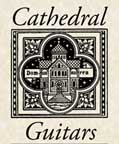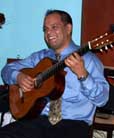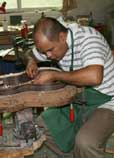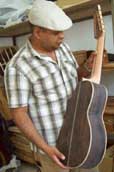 |
The Bartolex
Interview 4/28/2009 Second in a series of interviews covering players, composers and builders of multi-string guitars. [Interview: 1 | 2 ]. For USA / North America ordering information, please see BartolexUSA. For the rest of the world, please see Bartolex Neris Gonzalez: Guitarist, Luthier, and Mr. Bartolex |
||||||||||||||||||||
 NAMM, 2006 - Austin      |
1) CG: Are you a guitarist who became a luthier, or a luthier who became a guitarist? *** NG: I'm a guitar player that became a luthier. But I consider myself to be both a musician and a guitar builder at the same time. As a guitar player, I love all kinds of music and I try to play in several styles. As a luthier, I was taught to build electric guitars by Pavel De la Fuente, and my motivation to learn to make classical guitars was through Jose Yacopi (1916-2006). 2) CG: When did you first meet Jose Yacopi?
What kinds of things did you learn from him? After that I started selling his guitars, and exporting them to the USA, but that business was with his son, Fernando. Jose Yacopi was a true master, very humble, but also very confident about the quality of his guitars. All this inspired me to learn how to make guitars -- in the beginning, just out of curiosity, but then I really learned a lot working for Pavel. 3) Are you saying that you worked for Pavel de la Fuente? Did you make electric basses and guitars, or did you just work on acoustics? *** NG: Yes, I worked for him. I was his assistant / helper. He is really amazing at making electric basses and guitars, and of course, he can make all kinds of repairs. So I had the chance to watch him in action and learn first-hand how to make electric basses and guitars from scratch. You could give any crazy design to Pavel he would find the way to build it -- a very intelligent person. And also he is an excellent bass player. In the beginning he hired me because I was a guitar player, and he needed someone with a lot of guitar experience; then we became best friends. We did all kind of repairs on every conceivable stringed instrument, and we used to customize all kind of guitars and basses, and also build high-quality instruments. I worked on all the instruments but I always showed more of an interest in classical guitars. Although I could play all the guitars, the classical was my first instrument of choice, and the one I wanted to really understand. Then he opened a second workshop, and put me in charge of it. He continued making his instruments and doing repairs, and I also did all kind of repairs, along with customizing jobs on guitars and basses. This part was very important for me, I could really experiment, and with the help of Pavel, a few reference books, and some amount of courage, I never turned down any job. It really was a lot of fun, and I met important musicians that would hire me to repair their instruments, and sometimes also hire me out as a session guitar player. CG: 4) How did you start working for for Giannini? Is that when you first started to play the 7-string guitar? *** NG: My friend Renato DeMoraes contacted me about working for them. He and his partner, Georges Firmignac, were looking for a luthier that could help them with distributing Giannini guitars in USA. My job was basically Quality Control, Warranties, design and development of the new models, and also promoting the guitars in trade shows such as NAMM. They are great people, very friendly. They love what they do and made everything very easy for me. One day I was inspecting guitars and then I saw 7 string guitar! I thought it was a custom order, but Georges said, "that's just a 7-string, very common in Brazil, nothing special." Well maybe it wasn't special in Brazil but at that time nobody was selling those in the USA. I knew that jazz players would love to have a nylon 7 string. So I took one with me for a couple days and played it a lot. It was weird because when I felt I made some progress on the 7 string, I then had to make some recordings and play gigs with a regular 6-string guitar, and then I would forget everything I had learned on the 7 string! Finally, I decided to design my own guitars, I met some very interesting guitar makers in China and we started working together on Bartolex guitars. CG:5) How receptive were the Chinese luthiers to building your 10-string guitar designs? Did you have to talk them into it, or had they built multi-string guitars before? *** NG: They were already making 7-string guitars for the Brazilian and Japanese market. And they even had a prototype for a 10-string. So when I went to them, I only had to change a few details on the guitar's bracing and design. What really surprised me was every time I showed them something, they would be so hungry to learn more -- almost like kids. And once they learned something new, they were so happy and grateful for the new knowledge. So it was really easy to start working with them. They do have master luthier skills, and are very open minded about trying out new ideas. Also, they love their work -- they are very focused, working 8 hours a day like in any western country, but 8 hours with full concentration, and I really appreciate their level of commitment and dedication. 6) Do you see a new trend toward more people playing multi-string guitars? *** NG: I see a lot of 6-string guitar players willing to experiment with the 10-string. Now they can do it, in part, because they no longer have to pay $6,000.00 for a custom, hand-made 10 string. The majority of my customers found out it is relatively challenging to play the 10-string, and they have started developing a kind of method with their new Bartolex. Only a few players got frustrated by the extra strings, and usually they only tried it for a day or two before giving up, or deciding they weren't up to the challenge. I think that Bartolex guitars are really helping to promote the 10-string guitar: they purchase the guitar -- sometimes just out of curiosity -- and then they start asking me for method books, sources for strings, teachers, and other info. I always referred them to the 10-String Guitar Yahoo Group, as there is a lot of knowledgable players to be found there. Now that 10-strings are relatively affordable, we'll see a lot more newcomers willing to try them out, and I think the majority will be hooked on the multi string guitar world. Maybe we are helping to continue a big change that firsted started with Narciso Yepes, and perhaps in a couple of years 10-string guitars won't be considered "weird." 7) CG: A lot of people don't associate Chinese-built guitars with excellence in workmanship and materials, but doesn't China has a long history of high-quality classical instrument production? *** NG: Yes, that is indeed the myth about guitars made in China. In the past, it may have been true, but now it is a different story. Some people still associate China with being of sub-stand quality, but my Macbook Pro was made in China (and I consider it the best personal computer ever), all the iPhone components are made in China, VW cars, etc., etc. Regarding Chinese craftsmanship, last year I was out eating diner when my friend told me that I was sitting next to the top 4 violin makers in the world -- that they together had won more than 15 Gold Medals internationally, and guess what -- they were all Chinese!!! China has such a vast population, and they can be good at pretty much everything as a country. In a country of 30 million people, you will find that 1% are great athletes, and if some of them train properly, they can succeed and perhaps become Olympians. Well, imagine the numbers in a country with a population of 1.5 billion, and you get an idea of what is happening right now in China. They have already been making guitars here for decades -- there are so many factories here. Well some of the luthiers -- the talented ones -- became quite successful, and now they are masters (e.g. Eastman), plus some very open-minded luthiers came here and taught them during the last decade, now they are rich, because they can offer master guitars at affordable prices. When I came here, they almost knew everything already. I only had to show them something specific that I wanted once, and they could make immediately. Today, China is producing many things of very high quality. The same thing happened last century with the Japanese and Korean artisans. Of course, if you wanted, you could still find bad quality here. After all, there so many guitar factories here. Some of them make guitars for just $32.00, so what do you expect? Regarding tonewoods, today China is the world's biggest importer of tonewoods, so here you could easily find any wood in master-grade quality. Some of it expensive, but not much more than in other places. The Bartolex Standard Series use the traditional woods for guitars: Cedar, Englemann Spruce, East Indian Rosewood, Ebony, etc. In our Bartolex Custom Shop guitars, we also use Jacaranda do Bahia, Cocobolo, Madagascar Rosewood, African Blackwood, etc. If for any reason it's not already in stock, they know exactly who to order it from. CG 8) In addition to being a fan with your new Bartolex lattice-braced 10-string, I'm also impressed by the wide range on guitars you build: I have seen 6- 7- 8- 10- and 11- string guitars, Romantic period reproductions, 11-string alto guitars, and fan-fretted multi-string guitars. Are all these guitars part of your regular line? *** NG: I'm also very impressed with the Spruce / Lattice combination. Lattice was originally used on Cedar top only, but I really love it on Spruce tops. We made it once and results were amazing, now is becoming very popular. Usually I have 6-, 7- and 10- string guitars in my Standard Series, with different wood combinations according to what is the most popular. Also sometimes we make the same guitars but with scale variations and change some of the specs. We offer them as Standard Models with no extra charge, but we may not always have them in stock. Everything else is made in the Custom Shop. Here we make everything by hand, every heel, neck, top, etc., is made by hand-tools by our two Master Artisans. If it's possible, we can make it. Alto, 8-, 10-, 11-, and 12-string guitars, different shapes and bracing patterns, french polish, etc. The Custom Shop is the best option today to get the custom guitar of your dreams at a affordable price -- usually we charge just 40% - 50% of what you would have to pay individual luthiers. CG:9) What got you started in designing and
building multi-string guitars? *** NG: When I was working with Giannini Guitars, I saw that nylon 7 string guitar for the first time, and I immediately fell in love with it. Then in Austin, TX at the Summer NAMM show, a tall gentleman came over and asked me if Giannini would be interested in making 10 string guitars. He had a Ramirez 10 string guitar with him, and it had a beautiful sound. We discussed some ideas and quickly realized that no guitar company would want to invest in new models and molds in order to make an affordable 10 string guitar. I then realized there was an untapped market, and that nobody was really providing a solution. A couple of months later I decided to contact some small factories in China to start my own line of guitars, and my first priority was to make 7- and 10-string guitars. I showed them my designs, and my preferences for the building process, and we were able to make some great guitars with excellent quality, and I was really very happy with the result. Getting multi-strings guitars was once very difficult for the average player -- you could get them, but they were expensive, and had long waiting lists. Now this has drastically changed: you can get great 10-string guitars for under $2,000. 10) How did you arrive on your unusual company name of Bartolex guitars? Is there a story behind the name? *** NG: Bartolex -- ha ha!!! For me, there is a very funny story behind this: I had a friend who used to help me in my workshop, and for about 2 weeks he wouldn't stop singing this Spanish song about "Bartolo" who had flute with one hole only, and all the ladies were crazy for him. It's a funny song and once in your head, you can't stop singing it. About that time I also opened my Ebay account, and I had to choose an user ID name and I didn't have a clue, so I tried Bartolo, but it was already taken. Later I saw a sign with a word ending in "ex" so I chose "Bartolex". I was very successful selling guitars on Ebay with that name, so suddenly a customer from France asked: "Mr. Bartolex, could you get this guitar model for me?" Later one of his friends contacted me, calling me "Mr. Bartolex," and so on. So I became known as Mr. Bartolex. Then when it came time to register my brand and I couldn't resist -- so I apologize to all guitarists who wanted a more serious name for my brand, but they can be sure that the quality and service is the best. Btw., that tall gentleman I mentioned who inspired me to first start doing this -- I'd like to thank him for sharing his concerns. I even remember that he made me to have a picture taken with his Ramirez 10-string. That gentleman was you, Stephen -- thanks!!! **********
BARTOLEX (USA & North America): Visit us at GFA 2010
in Austin, TX |
|